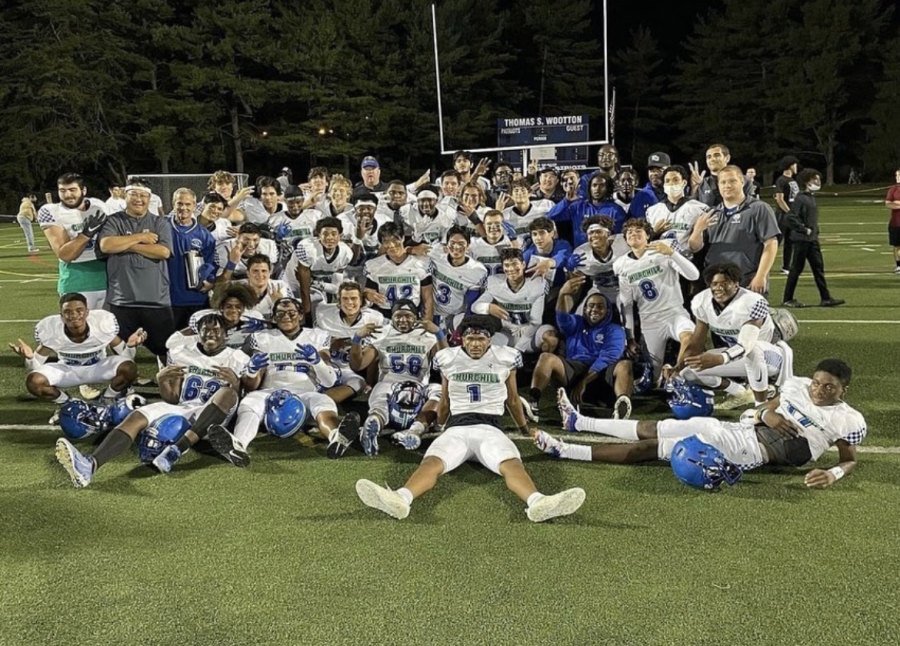It’s time for a change, invest in turf
Photo courtesy of @churchilldawgsfootball on Instagram.
WCHS teams already have to play on many turf fields against opponents like Wootton (as pictured above). Thus, getting a turf field makes it more unilateral for our teams.
May 8, 2022
What do Alabama football, Duke basketball and Vanderbilt baseball all have in common? They are all elite programs with elite facilities. There is a reason why the rich get richer in sports and that is because they have the best resources for their players. Although WCHS is certainly not a college, that is not a reason to continuously have subpar resources for our athletes. Therefore, it is necessary for WCHS athletics to make the switch to a turf field inside Shepherd Stadium.
Firstly, we have the resources. It is clear that WCHS has the money within its athletics program as our sports teams are lucky to get upgrades virtually every year. Some of the most recent upgrades include the new basketball scoreboard and the new baseball/softball field & banners. While turf fields are certainly more expensive than the upgrades previously listed, with the average price for a turf football field being hundreds of thousands of dollars, they are a great investment that has less maintenance costs in the long run and would be utilized for a variety of WCHS sports such as football, soccer and lacrosse, making the investment well worth it regardless of the cost.
Secondly, there are plenty of benefits to the turf field. For starters, it allows sports to be played in all types of weather, which has been a struggle for some teams, like lacrosse. Recently with the increased amount of rain in the spring, practice and games have had to be canceled.
Additionally, it conserves water. According to the Southern Nevada Water Authority, “the Southern Nevada Water Authority also estimates that every square foot of grass replaced with synthetic turf saves an additional 55 gallons of water per year. Therefore, an average lawn of 1,800 square feet will save 99,000 gallons of water a year if landscaped with synthetic turf.” If an average lawn can save almost 100,000 gallons, think about how much an entire football field will save.
Another benefit is that it keeps harmful pesticides out of our ecosystems. While these pesticides and fertilizers might help the growth of grass fields, they can also run off with rain and cause damage to the surrounding ecosystems. In fact, the EPA estimates that in Florida alone, “about 1,000 miles of rivers and streams, 350,000 acres of lakes and 900 square miles of estuaries are impaired by runoff of pesticides and fertilizers.” A turf field does not require such additives to grow and therefore would help the surrounding nature areas such as Great Falls, the Potomac River and Watts Branch Park steer clear of pesky chemicals.
To continue, while one might think that the rubber pellets that cover turf fields are just little nuisances that get stuck inside shoes, they do play a key part in limiting the amount of trash that goes into our landfills. Estimates from the Synthetic Turf Council have determined that the rubber pellets on turf fields in the United States are currently keeping 105 million used tires out of our landfills. In a society that is already facing the issues of too much nondegradable waste, the reuse of something as miniscule as used tires can go a long way. Thus, by getting a turf field we would be supporting a brighter future with less waste.
On a different note, turf fields limit the possibility of lumpy areas on a field that could cause injury. Although turf fields as a whole cause more minor injuries, most commonly abrasions known as “turf burn,” their ability to cause major injuries is significantly lower. Take FedEx Field, the home of the Washington Commanders, for example. There have been a number of major injuries that have occurred on that field due to a lack of conditioning such as Robert Griffin III’s torn ACL in 2013, Chase Young’s torn ACLin 2021 and most notable Alex Smith’s gruesome compound fibula/tibia fracture in 2018. While half of the league has already made the switch to a turf field, the Commanders did not and were forced to pay the price numerous times with major injuries.
These types of injuries would be even more brutal on the high school level, as players who want to be recruited for college sports would have their hopes dashed if they had to go through a year-long rehab program. Even those who do not want to be recruited should not have to miss such a long period of time because their school did not pony up a few more dollars for a safer turf playing surface.
To conclude, there are many reasons why it makes sense for Churchill to make the switch and invest in a turf field, with lower major injury risk, a cleaner environment and a better long term financial investment being just a few. Turf fields are truly the future of sports and it is time that Churchill take that next step if we truly want to show the county that we are an elite athletic program.



